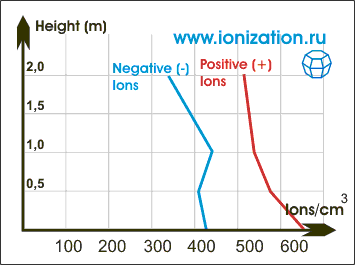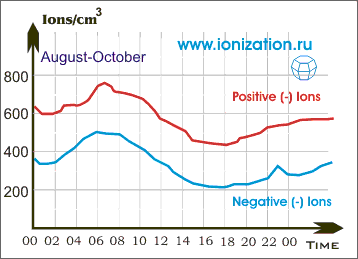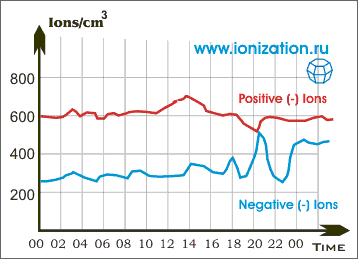Concentration of small ions in free atmosphere, its daily and seasonal correlation with other meteorological factors, such as humidity, wind direction and precipitations were studied very carefully both on the ground and on open sea. The most important results can be stated as following:
Observed quantity of small ions concentration changed from 100 up to 2000 ions per cubical centimeter, it concerned both polarities. Typical average quantity was: 150 ions per cubical centimeter - for cities, 500 - for countryside, 600 - for oceans.
It showed the influence of nucleuses concentration on concentration of small ions, it was determined that in the air of cities there was very high quantity of nucleuses and very low percent of nucleuses on open sea. It was defined that in normal weather ratio of positive ions concentration to negative ions concentration was n+/n->1, where the average quantity was between 1,0 and 1,4. But as it was observed during shower and thunderstorm this ration changes up to n+/n-<1.

If altitude above sea level increased, usually the concentration of small ions also increased. If there was no exchanging layer this altitude increase conformed the second level and it was caused by the increase of air ionization due to space rays and ultra-violet radiation. In the lowest air layer at a height of some meters above the ground the concentration of positive and negative ions was mainly determined by two effects: alpha and beta radiation from soil and radioactive gases (that influence better at low air pressure), which provoked equal increase of positive and negative ions concentration at decrease of altitude. Usually this effect could be observed in quiet weather. Concentration of positive ions increased at decrease of altitude ratio to negatively charged earth. The increase of negative ions concentration at decrease of altitude was partially compensated by electrode effect.
On picture 1 there was presented an example of vertical distribution of ions in regard to ground level. Blue line showed negative ions, red - positive ones. (Electronics Institute)

It seemed that daily variation of small ions concentration mainly depended on local conditions. Usually on the continent the maximum concentration was in the morning, the minimum - in the afternoon (Picture 2). There were few nucleuses above open sea and in polar zone, so day and night concentration of ions was nearly the same. On the other hand in the cities there was found an increase of amplitude effect of variations during the day. Though some analyses showed an irregular fluctuation of ions concentration without any periodicity.
In some researches seasonal fluctuations of small ions concentration showed that the maximum concentration is in summer and minimum - in winter. Mainly changes of nucleuses concentration in the air caused this fact.

In turn concentration of ions was determined by the local weather conditions. So, it was not novelty that there were found seasonal fluctuations of ions concentration, which differ from above mentioned ones. It turned out that dust, fog and high humidity decreased the concentration of small ions.
But during showers and thunderstorms concentration of negative ions greatly rose (Picture 3, shower was at 19-20 PM) and concentration of positive ions a bit rose.
Influence of wind was different; it depended on the direction of the wind. From what direction it blew, if from cities, it meant that there were a lot of nucleuses in the air and it would decrease the concentration of small ions. The ions counter was set at a height of 22 meters above earth. (Electronics Institute)
Sometimes it is possible to make the theoretical interpretation of the above mentioned researches in order to find out the balance between the formation of ions and their annihilation.
The article was edited and expanded from Upsala University Works (Norinder and Siksna)
THE FULL OR PARTIAL CITATION OF THIS ARTICLE IS FORBIDDEN (write to info@ionization.ru)




